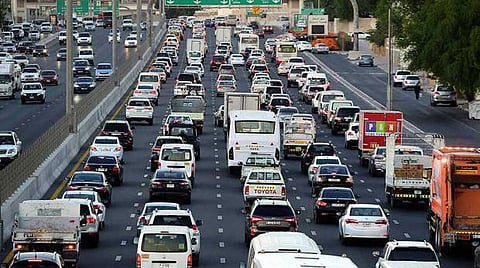Most UAE students use cars to reach school, worsening morning rush-hour traffic, study finds
New survey finds 66% students prefer cars, while only 16% use school buses

Dubai: A huge majority — 66 per cent — of UAE students use private cars to reach school in the morning, worsening rush-hour traffic, a new survey released on Monday revealed. Moreover, in almost 80 per cent of the cases, only one or two students travelled in each car, said the second part of the ‘UAE’s first-ever car occupancy survey’ by Noor Takaful Ethical Insurance and RoadSafetyUAE.
The survey’s first part was released in October, which showed that 74 per cent of school students were dependent on private cars, while only 22 per cent used public transport.
The use of other means of transport for the morning school run pales in comparison to use of cars. Only 16 per cent used the school bus in the morning. The rest of the students used taxis, limos or private vans (nine per cent), public transportation (six per cent) and “alternative modes of transportation” (three per cent) such as bicycles and scooters.
This survey was conducted by “a global, online research company” in March with a UAE representative sample of 1,005 respondents. More findings from the study can be found on RoadSafetyUAE’s website.
For students using cars, 36 per cent of parents were involved in dedicated school runs only; 19 per cent combined school runs with daily office commute; while 11 per cent said their drivers performed the dedicated school runs.
‘We’re a bit concerned’
Rajesh Sethi, CEO of Dar Al Takaful, the holding company of Noor Takaful, said: “We are a bit concerned to see such a high degree of individual traffic and very low utilisation of school transportation”. A high number of vehicles during rush hour can cause traffic congestions and also contribute towards avoidable pollution, he added. “Ideally, we would like to see more sustainable school transportation as a responsibility showcase for our children.”
Thomas Edelmann, founder and managing director of RoadSafetyUAE, said: “Certainly, the high number of private cars used for school runs and the low utilisation [of private vehicles], with just one to two children on board each private vehicle, adds to the morning congestion on UAE roads. From a road-safety perspective, we wish for fewer vehicles on the roads and would like to see more students using school buses, public transportation and alternative forms of transport, where possible. In addition, society will benefit from reduced air pollution. Just imagine how many private cars a single school bus filled to capacity can take off the road. These buses are operated by certified professional drivers and are equipped with state-of-the-art safety features to safeguard our children and the per capita eco-footprint is much smaller compared to individual cars. We would like to see creative solutions from the stakeholders to move away from individual transportation and towards aggregated transportation.”
School buses ‘critical’ to well-being
Steve Burnell, managing director, School Transport Services (STS) and also a CSR-Partner of RoadSafteyUAE, said: “Growth in school bus transportation is critical to the health and well-being of citizens in the UAE. Not only is it a requirement by many parents as the only form of transport to have safe access to schools, but it is also a fundamental part of the UAE’s 2030 vision on sustainability, de-carbonisation, and reduction in traffic congestion. Continuous engagement with the education sector, parents and students on the benefits of the school bus, and public transport in general, is vital.”
What the survey found
66 per cent of UAE students use private cars to reach school in the morning.
In almost four out of five cars, only or two students are on board.
In nearly one out of five cases, parents combine the school run with their office commute.
Only 16 per cent use the school bus in the morning.
The rest of the students use a taxi, limo or private van (9 per cent) or public transportation (6 per cent). ‘Alternative modes of transportation such as such as bicycles and scooters account for 3 per cent.
Sign up for the Daily Briefing
Get the latest news and updates straight to your inbox






